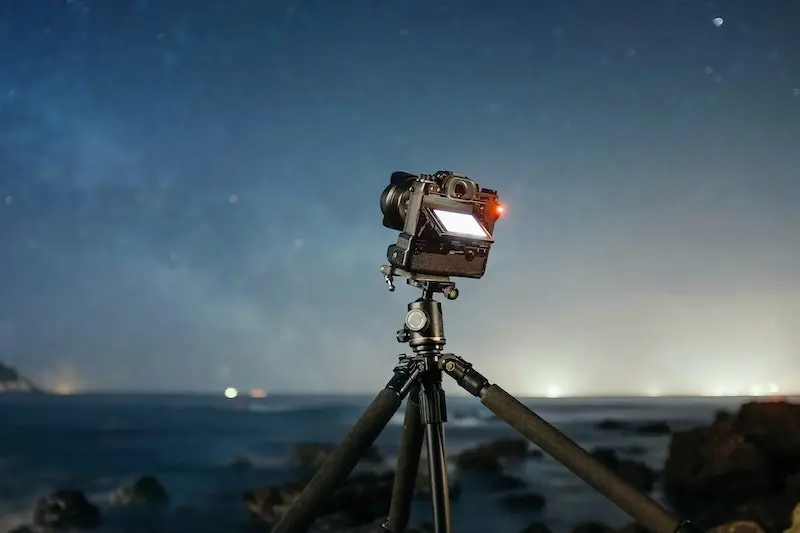The equipment needed for photography remains the main issue when embarking on this adventure. The camera body and lens are the heart of the equipment, but it is essential not to randomly select the other accessories since they represent a significant investment. This is the case for the camera tripod, which is usually the next purchase.
While many photographers manage to do without one, there are some conditions in which it is better to accompany your camera with a good-quality tripod. This accessory gives photographers stability and comfort. However, there are many options on the market, and it’s very easy to feel lost. The same questions often arise: how high should my tripod be? What weight should it be? What kind of stability? How much do they cost? Here are some answers.
Table of contents
Camera tripod system: What is it made of?
Before looking at the choice of tripod, let’s take a look at its composition. What is a tripod system? It is generally composed of:
- the legs, which are the most obvious part;
- a ball joint, the part that holds the camera;
- a central column, which is a separate leg that passes through the middle and allows the height to be adjusted;
- feet, which are located at the end of the legs and which can be changed according to the environment (generally indoors or outdoors).
The tripods used for photography are slightly different from those used for video. Here, we will focus on the tripods used for photography, whether they are accompanying a reflex or hybrid camera.

The benefits of using a tripod for photography
The tripod is an essential piece of equipment for a photographer. And for good reason, it has many advantages, including:
- better stability to avoid blurred photos as much as possible;
- improving the framing and composition of photos;
- improving the sharpness of the photos;
- a long exposure, which is especially useful for night photos.
Situations in which the use of a tripod is almost automatic include photos of the starry sky, fireworks or even panoramic views.
3 factors to help you choose your camera tripod
Many factors can play a role when it comes to choosing the best tripod for a camera, the three main ones being the manufacturing material, the weight it can support and its height.
Choose a camera tripod based on material and weight
One of the first factors to consider when purchasing a tripod is the material with which it is made, which has a direct impact on its weight. Today, most camera tripods on the market are made of aluminum or carbon. They are both resistant, but each has its advantages and disadvantages.
Aluminum tripods are the cheapest of the two, but they are also the heaviest. Carbon tripods are lighter, making them ideal for photographers who regularly carry their equipment. However, this means spending a little more money. But we mustn’t forget that a tripod is an investment and that it can accompany a photographer for years. In addition, the carbon tripod is more resistant to extreme conditions, including cold. Portability is a factor that should not be minimized when choosing the ideal tripod for your photography activity, especially if you travel a lot. Indeed, choosing a tripod that is too heavy increases the chances of you leaving it at home to avoid having to carry it.
Choose a camera tripod based on the weight it can support
The role of the tripod is to support the camera. It is therefore necessary to know precisely how much your equipment weighs – camera and lenses combined – in order to choose one strong enough to support the total weight. It is generally recommended to select a tripod that is at least 1.5 times the total weight of the camera and the heaviest lens.
It must also be taken into account that the photographer exerts some pressure when taking photos. A poorly chosen tripod quickly weakens and has a good chance of yielding to weight. It also means taking the risk of damaging your camera and lens, as they may fall off. It is better to put in a little more money upfront to get a really good tripod than to have to reinvest in your basic equipment, which represents a high cost.
Choose a camera tripod based on your height
Height is another key point when choosing a tripod. There are two maximum heights: the one with the central column raised and the one with the central column not raised. It is important to choose the right size to avoid having to lean over too often and consequently becoming physically tired. The feet of the tripod must reach approximately the level of the photographer’s shoulders, without the extension of the central column. If the tripod is purchased with the head, the head must be able to reach the level of the photographer’s eyes. The minimum height can be interesting for some photographers, especially if they want to take pictures from very close to the ground.
The height of the tripod is even more important for photographers who have to travel regularly and carry it in a bag, luggage, or something else. Be careful, tripods that can be folded more easily are generally those that offer the least stability: you must therefore be clear about your priorities and needs. It is interesting to note that it is better to have a larger tripod than a smaller one.

Some tips for using a camera tripod
There are a few tips that allow you to optimize the use of a tripod. In particular, it is advisable to:
- unfold the feet completely only when it is really necessary, because the more the feet are unfolded, the more stability is lost;
- extend the central column only when the additional height is necessary;
- install the tripod only after ensuring that the ground underneath it is clear and level.
By following these tips, we ensure that our equipment is protected to the best of our ability. Manfrotto, Sirui and Vanguard are three brands known for offering very high-quality tripods. We must not forget: a tripod is an investment for life.
- Everything you need to know to get started in photography
- How do I choose the right lens for a camera?
- How do I choose an external flash?
- What equipment should I use to take portrait photos?
- What equipment should I use to take landscape photos?
- Which computer should I choose for photo editing?
- How do I create a photo studio?
- Lighting solutions in photography
- Equipment for creating sports photos
- Equipment for wildlife photography
- How can I develop my own photos?









